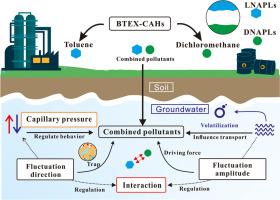Towards characterizing LNAPLs and DNAPLs co-transport under groundwater table fluctuation conditions
IF 6.3
2区 环境科学与生态学
Q1 ENVIRONMENTAL SCIENCES
引用次数: 0
Abstract
The transport behavior of pollutants under dynamic groundwater conditions has attracted significant attention recently. However, there is limited research on the simultaneous effects of groundwater table fluctuations on the transport of co-existing pollutants, especially combined dense and light non-aqueous phase liquids (DNAPLs and LNAPLs). In this study, column experiments investigated toluene and dichloromethane transport in a controlled water table system with varying fluctuation conditions. Results showed that both dichloromethane and toluene accumulated near the groundwater table under static water table conditions, but the concentration of dichloromethane declined more rapidly than toluene due to differences in their physicochemical properties, such as solubility, density, and hydrophobicity. Groundwater fluctuations facilitated pollutants transportation towards deeper layers, potentially resulting in unforeseen increases in pollutant volatilization and downward fluxes. The interactions between dichloromethane and toluene, including competitive adsorption, enhanced dissolution, and altered kinematic viscosities, resulted in the reduced transport potential of dichloromethane while enhancing that of toluene. Furthermore, compared to dichloromethane, the initial upward fluctuation of the water table had a more pronounced impact on toluene due to its lower solubility and volatility. The downward transport risk index assessment indicated that among various factors considered, groundwater fluctuation amplitude exerted the most significant influence on pollutant migration risk. These new findings will provide important insights into understanding and assessment of the potential transport risk associated with combined LNAPLs and DNAPLs in the natural environment.

地下水位波动条件下LNAPLs与DNAPLs共输特性研究
地下水动态条件下污染物的运移特性是近年来研究的热点问题。然而,关于地下水位波动对共存污染物运移的同步影响,特别是对重、轻复合非水相液体(DNAPLs和LNAPLs)的影响研究有限。本研究采用柱形实验研究了不同波动条件下受控地下水位系统中甲苯和二氯甲烷的运移。结果表明:在静态地下水位条件下,二氯甲烷和甲苯均在地下水位附近积聚,但由于其溶解度、密度和疏水性等理化性质的差异,二氯甲烷的浓度下降速度快于甲苯。地下水波动促进了污染物向较深层的运移,可能导致污染物挥发和向下通量的不可预见的增加。二氯甲烷和甲苯之间的相互作用,包括竞争性吸附、增强溶解和改变运动粘度,导致二氯甲烷的运输势降低,而甲苯的运输势增强。此外,与二氯甲烷相比,由于其溶解度和挥发性较低,地下水位最初的上升波动对甲苯的影响更为明显。向下迁移风险指数评价表明,在考虑的各因素中,地下水波动幅度对污染物迁移风险的影响最为显著。这些新发现将为理解和评估自然环境中与LNAPLs和DNAPLs联合相关的潜在运输风险提供重要见解。
本文章由计算机程序翻译,如有差异,请以英文原文为准。
求助全文
约1分钟内获得全文
求助全文
来源期刊

Journal of Environmental Sciences-china
环境科学-环境科学
CiteScore
13.70
自引率
0.00%
发文量
6354
审稿时长
2.6 months
期刊介绍:
The Journal of Environmental Sciences is an international journal started in 1989. The journal is devoted to publish original, peer-reviewed research papers on main aspects of environmental sciences, such as environmental chemistry, environmental biology, ecology, geosciences and environmental physics. Appropriate subjects include basic and applied research on atmospheric, terrestrial and aquatic environments, pollution control and abatement technology, conservation of natural resources, environmental health and toxicology. Announcements of international environmental science meetings and other recent information are also included.
 求助内容:
求助内容: 应助结果提醒方式:
应助结果提醒方式:


